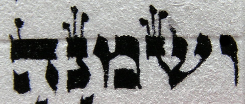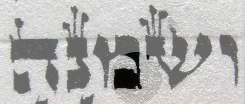This stage is a tricky one, because there's always, always going to be stuff you could have done better, and if you're not careful you'll drive yourself into a frenzy of ever more microscopic tweaking, far beyond the point where it could possibly make a difference. Balancing artistic integrity and realism is a skill that has application beyond Torah proofreading, though, so it's a good skill to learn regardless.

Here's an example. That mem could be prettier.

This is a level of detail I think you can only apply to yourself or your student. Applying it to someone else's writing is just wrong on so many levels – pragmatically idiotic and technically unrealistic, as well as being an exercise in fantastic subjectivity, hyper-criticism, and wishful thinking.
For instance, if you have a Torah that's getting on in years, some of its letters are not going to be as pretty as they once were. Fact of life. You could spend months going over it and restoring each letter to perfection, but like any invasive cosmetic procedure, there's only so much that's going to help; at some point it's better to accept it as is.
But this is a new Torah and I wrote it, so if I want to make that mem prettier, I will.




Will you talk about computer checking at some point? I'd like to know how the computer program knows enough Torah to tell you when there's a mistake.
ReplyDeleteYes, parts 20 through 24. Coming right up :)
ReplyDelete